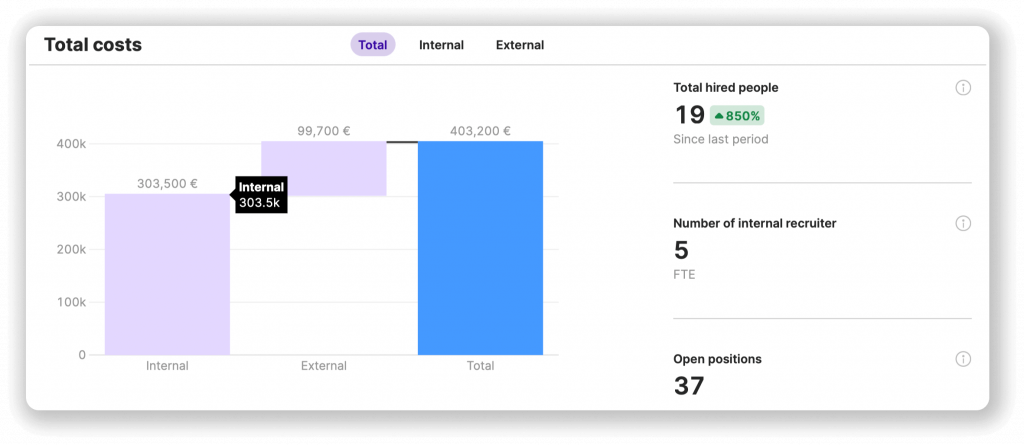Foundations
People Analytics Strategy – How to successfully implement people analytics?
- By Nick Stodt
05 Feb

In our previous article, You are responsible for people analytics: But what is the best way to start? we looked at the challenges of people analytics. We described key steps that can help ensure the success of the initiative, such as getting access to the right data, planning the distribution & communication of the data throughout the organization, and understanding the context of the organization and the data. But what makes a successful people analytics strategy and how do you sustainably implement people analytics in your organization?
TL;DR
People analytics can add significant value to organizations if implemented correctly. But how to ensure that the people analytics initiative is successfully and sustainably implemented in the organization? It is important to find the right balance between “how can I show short-term success and thus the added value of People Analytics?” and “how can I ensure long-term and sustainable implementation of People Analytics in the organization?”. As a teaser in advance – try to avoid overly complex data analysis on a poor data foundation and focus on analyzing robust data from your systems and individual use cases.
But how do you show the added value of people analytics to the business? You’ll learn about the important points you should consider in your strategy and implementation in the following sections.
The right people analytics strategy boosts business success
People analytics is an important part of a successful business strategy. By analyzing data about employee behaviour and performance, a comprehensive people analytics strategy can help drive business value. In addition, such a strategy can help improve employee retention by ensuring that employee needs and desires are captured and incorporated into decisions. Improved employee retention, in turn, can lead to higher performance and a more positive workplace culture. In short, a comprehensive people analytics strategy can help improve an organization on many levels.
Why clearly defining the problem is so important
Successful implementation of people analytics begins with identifying clear problems to solve. This could be improving the efficiency of recruiting channels or improving employee engagement, for example. It is important to clearly define these problems before getting started with creating a people analytics strategy. A well-defined problem statement provides clear direction for analysis and helps focus on the data and analytics that are best suited to solve the problem. An overview of the most important HR metrics in the areas of People, Recruiting, Retention, Performance, Engagement, DEI and Strategic Planning, can be found here:
Align people analytics strategy with business objectives
A clear people analytics strategy is critical to an organization’s success. By aligning the people analytics initiative directly with business goals, you can ensure that the data and analytics collected help improve business outcomes. For example, linking employee engagement and business performance can be an important factor in delivering clear value to the organization.
Find the right balance between short-term successes and long-term implementation of people analytics
To successfully implement people analytics, it’s important to find the right mix between short-term successes and long-term implementability. While a quick improvement in one area is gratifying, if it cannot be sustained over the long term, it is not sustainable. It is therefore critical to develop a people analytics strategy that not only meets the needs of the business and the expectations of employees but also aims to sustain implementation.
Avoid complex analytics with messy data and analysis without real added value for the company
It is important that people analytics initiatives are well-planned and implemented to add real value to the business. Avoid using messy data or focusing too much on data fundamentals without a practical benefit, as this can lead to inaccurate or unusable results. Instead, maintain a healthy mix between data analytics and practical applications to ensure that people analytics benefits business goals and delivers value.
Quantifying insights from people analytics
Quantification plays a critical role in assessing the value of people analytics. It is important to identify clear metrics and metrics that make the impact of people analytics on the business measurable. Here, it can be direct by demonstrating a tangible benefit to the business or indirect by showing improved performance or management through data. In addition, it can also be demonstrated through the positive reactions of stakeholders that people analytics deliver value to the business.
As little complexity as necessary
People analytics is an important part of modern HR, using data and analytics to drive better HR decisions and outcomes. However, it is important to note that too much complexity is not always beneficial. A people analytics strategy should therefore carefully consider whether increased complexity is necessary to add value and be important to stakeholders. Excessive complexity can even have a negative impact by reducing overview and comprehension, making decision-making more difficult. If you want to learn more about specific uses of people analytics, check out our people analytics use cases in people, recruiting, retention, and DEI:
Active management, data literacy, and a data-driven decision culture
People analytics offers a unique opportunity to leverage data and analytics to make better HR decisions. However, to realize the full benefits of people analytics, successful implementation depends on three important factors: active management, data literacy, and a culture that values evidence-based decision-making. Active management is necessary to guide the project and ensure it is aligned with business goals and values. Data literacy is required to collect, analyze, and interpret the data to make informed decisions. And a culture that values evidence-based decision-making is important to ensure that people analytics results are appropriately considered and acted upon. In short, successful implementation of people analytics requires strong management, a deep understanding of data, and a culture focused on facts and evidence.
We hope the article helps you understand and prioritize the key steps for a successful people analytics strategy and implementation. If you want to learn more about the topic, we recommend you to read the following articles:
Want to get started with people analytics in your organization?
peopleIX connects all your HRIS, ATS and other HR data sources to create a unified view of your workforce. Get a personalized demo around your unique pain points and discuss your company’s specific needs. Find out how peopleIX can help you on your people analytics journey. Or discover our use cases in the areas of people, recruiting, retention and DEI.
You can find more information on the topic of strategy and implementation of people analytics at the Academy to innovate HR in this article: https://www.aihr.com/blog/people-analytics-strategy/
Related Post
Recent Posts

Investing in Your HR Team: The Impact on Company Growth
January 31, 2024Categories
- Analytics (2)
- Collaboration (1)
- Customer Sucess Stories (1)
- Data Management (1)
- Foundations (9)
- Human Resources (HR) (3)
- Platform (1)
- Recession Times (2)
- Tech Stack (1)
- Use Cases (4)
PRODUCT
People Planning & Scenarios
Sharing & Collaboration
RESOURCES
LEVEL UP
STAY IN THE LOOP
Copyright © 2024 peopleIX GmbH. All rights reserved.





